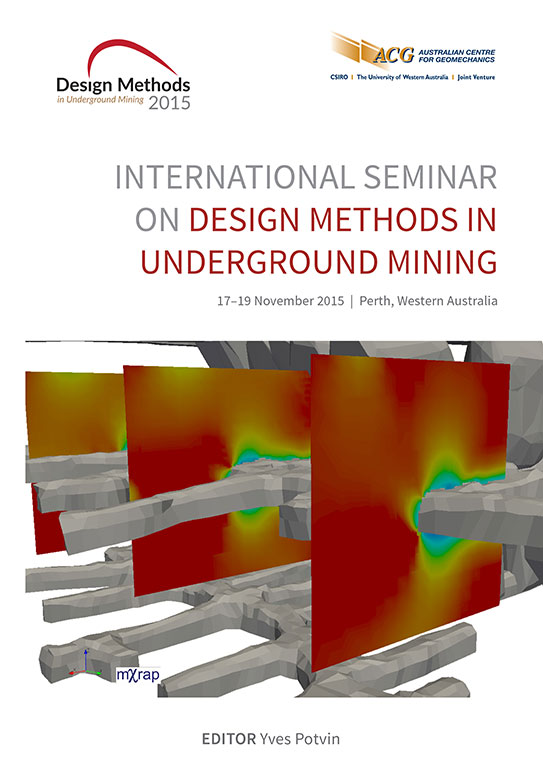Design approach for squeezing ground

|
Authors: Varden, RP; Woods, MJ |
DOI https://doi.org/10.36487/ACG_rep/1511_30_Varden
Cite As:
Varden, RP & Woods, MJ 2015, 'Design approach for squeezing ground', in Y Potvin (ed.), Design Methods 2015: Proceedings of the International Seminar on Design Methods in Underground Mining, Australian Centre for Geomechanics, Perth, pp. 489-504, https://doi.org/10.36487/ACG_rep/1511_30_Varden
Abstract:
Many mines experience squeezing ground conditions due to orebodies located in weak rock masses. Often, the conditions leading to squeezing ground are not recognised or underestimated at the feasibility stage, leading to significant difficulties in mining the deposit, high costs and lost resources. There are a number of processes to determine the potential existence and degree of squeezing ground. Feasibility study to determine the rock mass behaviour will significantly reduce the risks associated with mining such deposits. In many cases, it is not possible to prevent squeezing occurring; however, good planning at the feasibility stage can provide the means to control the ground to allow economical extraction. The aim of this paper is to present an approach to maintain access development in squeezing ground identified during the feasibility study. Much is written about squeezing ground, but mainly about how to solve a problem that has already occurred (Potvin & Hadjigeorgiou 2008; Sandy et al. 2007). The aim of this paper is to give guidance for planning and management solutions for a deposit that will likely encounter squeezing ground conditions. The paper will also discuss operational requirements that need to be considered at the preproduction stage. The paper reviews ground control schemes aimed at controlling movement before and during stoping. It is based on experiences and research conducted at mines experiencing squeezing ground conditions and reviews considerations in design and monitoring to mitigate outcomes associated with squeezing rock masses.
References:
Aydan, Ö, Akagi, T & Kawamoto, T 1993, ‘The squeezing potential of rock around tunnels: theory and prediction’, Rock Mechanics and Rock Engineering, vol. 2, pp. 137-163.
Barla, G 1995, ‘Squeezing rocks in tunnels’, ISRM News Journal, vol. 3, no. 2, pp. 44-49.
Beck, DA & Duplancic, P 2005, ‘Forecasting performance and achieving performance indicators in high stress and seismically active mining environments’, in Y Potvin & M Hudyma (eds), Proceedings of the Sixth International Symposium on Rockburst and Seismicity in Mines (RaSiM6), Australian Centre for Geomechanics, Perth, pp. 409-418.
Beck, DA, Lilley, CR, Reusch, F, Levkovitch, V, Putzar, G & Flatten, A 2013, ‘A preliminary, calibrated scheme for estimating rock mass properties for non-linear, discontinuum models’, Proceedings of the 3rd ISRM Symposium on Rock Mechanics (Sinorock 2013), International Society for Rock Mechanics, Lisboa, 6 p.
Bhasin, R & Grimstad, E 1996, ‘The use of stress – strength relationships in the assessment of tunnel stability’, Tunneling and Underground Space Technology, vol. 11, no. 1, pp. 93-98.
Hoek, E 2001, ‘Big tunnels in bad rock’, ASCE Journal of Geotechnical and Geoenvironmental Engineering, vol. 127, no. 9,
pp. 726-740.
Lee, M, Pascoe, M & Mikula, P 2001, Virgin rock stresses vs rock mass strength in Western Australia’s Yilgarn greenstones’, Proceedings of the WA Ground Control Workshop, Australian Mining Consultants Pty Ltd, Melbourne, 41 p.
Norwegian Geotechnical Institute 2013, Using the Q-system handbook: rock mass classification and support design, Norwegian Geotechnical Institute, Oslo.
Potvin, Y & Hadjigeorgiou, J 2008, ‘Ground support strategies to control large deformations in mining excavations, Journal of the Southern African Institute of Mining and Metallurgy, vol. 108, pp. 393-400.
Sandy, M, Gibson, W & Gaudreau, D, 2007, ‘Canadian and Australian Ground Support Practices in High Deformation Environments’, in Y Potvin (ed.), Proceedings of the Fourth International Seminar on Deep and High Stress Mining (Deep Mining ’07), Australian Centre for Geomechanics, Perth, pp. 297-311.
Singh, B, Jethwa, JL, Dube, AK & Singh, B 1992, ‘Correlation between observed support pressure and rock mass quality’, Tunnelling and Underground Space Technology, vol. 7, no. 1, pp. 59-74.
Singh, M, Singh, B & Choudhari, J 2007, ‘Critical strain and squeezing of rock mass in tunnels’, Tunnelling and Underground Space Technology, vol. 22, pp. 343-350.
Varden, R, Lachenicht, R, Player, J, Thompson, A & Villaescusa, E 2008, ‘Development and implementation of the Garford dynamic bolt at the Kanowna Belle Mine’, Proceedings of the 10th Underground Operators’ Conference, The Australasian Institute of Mining and Metallurgy, Melbourne, pp. 95-102.
Villaescusa, E, Thompson, A, Player, J & Morton, E 2010, Dynamic testing of ground control systems, MERIWA report, no. 287, Project M349A, Minerals and Energy Research Institute of Western Australia, Perth.
Zhou, Y & Zhao, J (eds) 2011, Advances in rock dynamics and applications, CRC Press, Boca Raton, FL.
© Copyright 2025, Australian Centre for Geomechanics (ACG), The University of Western Australia. All rights reserved.
View copyright/legal information
Please direct any queries or error reports to repository-acg@uwa.edu.au
View copyright/legal information
Please direct any queries or error reports to repository-acg@uwa.edu.au